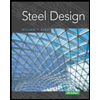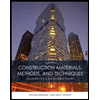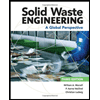
(a)
The strain in composite when stress in matrix is
(a)
Answer to Problem 12.14P
The strain in composite when stress in matrix reaches
Explanation of Solution
Given:
Elastic modulus of polycarbonate matrix is
Maximum allowable stress in matrix is
Concept used:
Write the expression for strain in composite.
Here,
Calculation:
Substitute
Conclusion:
Thus, the strain in composite when stress in matrix reaches
(b)
The fiber stress for continuous fiber composite and identify if this is less than tensile strength of fiber.
(b)
Answer to Problem 12.14P
The fiber stress for continuous fiber composite is
Explanation of Solution
Given:
Elastic modulus of Fiber is
Concept used:
Write the expression for fiber stress.
Here,
Calculation:
Substitute
Conclusion:
Thus, the fiber stress for continuous fiber composite is
(c)
Critical fiber length
(c)
Answer to Problem 12.14P
Critical fiber length is
Explanation of Solution
Given:
Diameter of aramid fiber is
Shear strength of Polycarbonate-aramid interface is
Concept used:
Write the expression for critical aspect ratio.
Here,
Calculation:
Substitute
Conclusion:
Thus, the Critical fiber length is
(d)
Average stress in chopped aramid fiber.
(d)
Answer to Problem 12.14P
Average stress in chopped aramid fiber is
Explanation of Solution
Given:
Length of aramid fiber is
Concept used:
Write the expression for average fiber stress.
Here,
Calculation:
Substitute
Conclusion:
Thus, the average stress in chopped aramid fiber is
(e)
Composite material stress.
(e)
Answer to Problem 12.14P
Composite material stress is
Explanation of Solution
Given:
Volume percentage of aramid chopped fiber is
Volume percent of polycarbonate matrix is
Tensile strength of aramid fiber is
Tensile strength of Polycarbonate is
Concept used:
Write the expression for composite material stress.
Here,
Calculation:
Substitute
Conclusion:
Thus, the composite material stress is
Want to see more full solutions like this?
Chapter 12 Solutions
Materials Science and Engineering Properties, SI Edition
- A tension member made of L4x4x1/2 is connected to gusset plate with welds. Using E70electrode and ½ inch weld size, design the balanced weld lengths.( Use AISC manual, LRFD units)(Previous solution was incorrect)arrow_forwardQ1: determine the area of steel for the slab that rests on brick walls and is shown in the figure. Use the following data: f'c = 25 MPa, fy = 420 MPa, L.L. = 1.5 kN/m², D.L. = 3 kN/m² (without self-weight). Rate from (1 to 4) your ability to solve the problem 7 m 0.3 m 0.3 marrow_forwardA rigging job calls for lifting a structure that weighs 150 tons. Two cranes are available, one with a rated capacity of 85 tons and the other with a rated capacity of 120 tons. The total weight of the rigging required to make the lift is 15 tons, of which 10 tons is to be carried by the larger craneand 5 tons is to be carried by the smaller crane. If the cranes are to be loaded in proportion to their net capacities, what should be the approximate net load on the 120-ton crane?arrow_forward
- I need detailed help solving this exercise from homework of Engineering Mathematics II.I do not really understand how to do, please do it step by step, not that long but clear. Thank you!P.S.: Please do not use AI, thanks!arrow_forwardI need detailed help solving this exercise from homework of Engineering Mathematics II.I do not really understand how to do, please do it step by step, not that long but clear. Thank you!P.S.: Please do not use AI, thanks!arrow_forwarda) For the truss shown in Fig 2, determine the stiffness matrices of elements 2, 3 and 4 in the in the global co-ordinate system. Assume for each member A = 0.0015 m2 and E = 200 GPa. Indicate the degrees-of freedom in all the stiffness matrices. b) Determine the stiffness matrix of the whole truss in the global co-ordinate system. Clearly indicate the degrees-of freedom numbers in the stiffness matrix. c) Calculate all the nodal displacements and all the member forces of the truss.arrow_forward
- I want an answer very quickly, pleasearrow_forwardI want an answer very quickly, pleasearrow_forwardQ1/ Choose the correct answer for the following: 1- Cantilever retaining walls is suitable for retaining backfill about a- 8m d-4m b- 12m c- 2m e- Any height 2-The shear key is provided to a- Avoid friction behind the wall d- All of the above b- Improve appearance e- None of the above c- Increase passive resistance types of retaining wall may b- Semi-gravity retaining walls d-Counterfort retaining walls be classified as follows: 3- The common a- Gravity retaining walls walls c- Cantilever retaining e- All the mentioned 4-Related to Stability of RW, Which of the following does not represent a potential failure mode for a retaining wall? a-Bearing capacity failure of the foundation soil. b- Wall cracking due to thermal expansion. c- Excessive settlement due to weak soil layer. d- Shear failure within the foundation soil adjacent to the wall. e-Sliding along the base due to insufficient friction. 5- If the desired factor of safety against sliding is not met, which strategy is NOT a…arrow_forward
 Materials Science And Engineering PropertiesCivil EngineeringISBN:9781111988609Author:Charles GilmorePublisher:Cengage Learning
Materials Science And Engineering PropertiesCivil EngineeringISBN:9781111988609Author:Charles GilmorePublisher:Cengage Learning Steel Design (Activate Learning with these NEW ti...Civil EngineeringISBN:9781337094740Author:Segui, William T.Publisher:Cengage Learning
Steel Design (Activate Learning with these NEW ti...Civil EngineeringISBN:9781337094740Author:Segui, William T.Publisher:Cengage Learning Construction Materials, Methods and Techniques (M...Civil EngineeringISBN:9781305086272Author:William P. Spence, Eva KultermannPublisher:Cengage Learning
Construction Materials, Methods and Techniques (M...Civil EngineeringISBN:9781305086272Author:William P. Spence, Eva KultermannPublisher:Cengage Learning Engineering Fundamentals: An Introduction to Engi...Civil EngineeringISBN:9781305084766Author:Saeed MoaveniPublisher:Cengage Learning
Engineering Fundamentals: An Introduction to Engi...Civil EngineeringISBN:9781305084766Author:Saeed MoaveniPublisher:Cengage Learning Solid Waste EngineeringCivil EngineeringISBN:9781305635203Author:Worrell, William A.Publisher:Cengage Learning,
Solid Waste EngineeringCivil EngineeringISBN:9781305635203Author:Worrell, William A.Publisher:Cengage Learning,




